Students rely on Class 6 Maths Extra Questions Chapter 2 Lines and Angles Class 6 Extra Questions and Answers to improve their grades.
Class 6 Maths Chapter 2 Extra Questions Lines and Angles
Class 6 Maths Lines and Angles Extra Questions
NCERT Class 6 Maths Chapter 2 Lines and Angles Extra Questions and Answers
Very Short Answer Type Questions
Question 1.
Use the following figure to name

(i) all the points
(ii) two rays
Answer:
(i) The points are O, A, B and C.
(ii) Two rays are \(\overrightarrow{O A}\) and \(\overrightarrow{O C}\).
Question 2.
Name all the line segments in given figure.
![]()
Answer:
All the line segments are \(\overline{P Q}, \overline{P R}, \overline{P S}, \overline{Q R}, \overline{Q S}\) and \(\overline{R S}\).
Question 3.
Name the line segments shown in the figure given below.

Answer:
The line segments are \(\overline{A B}, \overline{B C}, \overline{C D}, \overline{D E}\) and \(\overline{A E}\).
Question 4.
Consider the following figure and write the name of
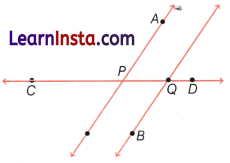
(i) a ray which contains point A.
(ii) a ray which contains point B.
Answer:
(i) Ray, which contains point A is \(\overrightarrow{P A}\).
(ii) Ray, which contains point B is \(\overrightarrow{Q B}\).
Question 5.
Write all exterior and interior points of the given figure.

Answer:
Here, interior points are H, I and exterior point is M.
Question 6.
Name the vertices in given figure.
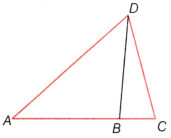
Answer:
The vertices in the above figure are A, B, C and D.
![]()
Question 7.
Write vertex of opposite side of AB and SC of the given figure.

Answer:
Vertex of opposite side of AB is C and of BC is A.
Question 8.
Write all vertices of the given figure.
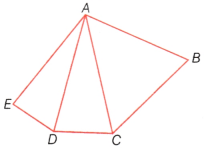
Answer:
In the given figure, vertices are A,B,C,D and E.
Question 9.
The number of common points in the two angles marked in the given figure is __

Answer:
The common point in ∠BAC and ∠DAE is point A.
Question 10.
List out English alphabets which are examples of perpendicular. Write, if any.
Answer:
Letter F, L and T are example of perpendicular lines.
Question 11.
The figure given below shows a tyre of a bicycle.

What type of angle does Spoke 1 make with Spoke 11?
Answer:
Spoke 1 makes reflex angle and obtuse angle with spoke 11.
Short Answer Type Questions
Question 1.
By simple looking at the pair of angles given below. State which of the angles in each pair is greater.
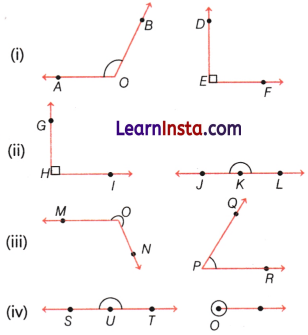
Answer:
From the given figures, we can say that
(i) ∠AOB > ∠DEF
(ii) ∠JKL > ∠GHI
(iii) Reflex angle ∠MON > ∠QPR
(iv) ∠O > ∠SUT
Question 2.
In the given figure, list the points which
(i) are in the interior of ∠AOB.
(ii) are in exterior of ∠AOB.
(iii) lie on ∠AOB. Competency Bafced Question
Answer:
(i) The interior points of ∠AOB are S and Q.
(ii) The exterior points of ∠AOB are P and R.
(iii) The points, which lie on ∠AOB are A, O, B, T and N.
![]()
Question 3.
In the given figure, write

(i) name of the vertex of ∠3.
(ii) name of the common arm of ∠1 and ∠2.
(iii) name Of the vertex of ∠4.
Answer:
(i) The vertex of ∠3 is B.
(ii) Common arm of ∠1 and ∠2 is AC.
(iii) The vertex of ∠4 is C.
Question 4.
Write down six angles involved in the given figure.

Answer:
Six angles involved in the above figure are ∠ABC, ∠BCA, ∠CAB, ∠AEC, ∠ABD and ∠DBC.
Question 5.
Classify each one of the following angles as right, straight, acute, obtuse or reflex.

Answer:
(i) Acute angle
(ii) Obtuse angle
(iii) Reflex angle
(iv) Obtuse angle
(v) Acute angle
(vi) Reflex angle
Question 6.
Is it possible for the same
(i) line segment to have two different lengths?
(ii) angle to have two different measures?
Answer:
(i) No, a line segment cannot have two different lengths
(ii) No, an angle cannot have two different measurements.
Question 7.
State the type of angle in the following.

Answer:
In the given figures, we have
(i) ∠AOB is a right angle.
(ii) ∠AOB is a straight angle.
(iii) ∠AOB is an acute angle.
(iv) ∠AOB is an obtuse angle.
(v) ∠AOB is an obtuse angle.
(vi) ∠O is a complete angle.
Long Answer Type Questions
Question 1.
Name the points and then the line segments in each of the following figures.

Answer:
(i) The points are A, B, C and line segments are \(\overline{A B}, \overline{A C}, \overline{B C}\).
(ii) The points are A, B, C, D and line segments are \(\overline{A B}, \overline{B C}, \overline{C D}, \overline{A D}\).
(iii) The points are A, B, C, D, E and line segments are \(\overline{A B}, \overline{B C}, \overline{C D}, \overline{D E}, \overline{A E}\).
(iv) The points are A, B, C, D, E, F and line segments are \(\overline{A B}, \overline{C D}, \overline{E F}\).
![]()
Question 2.
Name the following angles of figure using three alphabets.

(i) ∠1
(ii) ∠2
(iii) ∠3
(iv) ∠1 + ∠2
(v) ∠2 + ∠3
(vi) ∠1 + ∠2 + ∠3
(vii) ∠CBA – ∠1
Answer:
Name of the angles are as follows
(i) ∠1 = ∠CBD
(ii) ∠2 = ∠DBE
(iii) ∠3 = ∠EBA
(iv) ∠1 + ∠2 = ∠CBE
(v) ∠2 + ∠3 = ∠DBA
(vi) ∠1 + ∠2 + ∠3 = ∠CBA
(vii) Put the value of ∠CBA
∠CBA = ∠1 + ∠2 + ∠3
Now, ∠CBA – ∠1 = ∠1 + ∠2 + ∠3 – ∠1 = ∠2 + ∠3 = ∠DBA
[∵ ∠DBA = ∠2 +∠3]
Question 3.
Using the given information, name the right angles in the following figures.

Answer:
(i) Since, AC _L BD, it means ∠E = 90°.
∴ ∠AEB, ∠BEC, ∠CED and ∠AED are right angles.
(ii) Since, AE1CE, it means ∠E = 90°
∴ ∠AEC is a right angle.
(iii) Since, AC ± CD, it means ∠C =90°
∴ ∠ACD is a right angle.
(iv) Since, OP _L AB, it means ∠K = 90°
∴ ∠AKO, ∠OKB, ∠BKP and ∠AKP are right angles.
Question 4.
What conclusion can be drawn in each part of figure?
(i) DB is the bisector of ∠ADC.

(ii) BD bisects ∠ABC.

(iii) DC is the bisector of ∠ADB, CA ⊥ DA and CB ⊥ DB.

Answer:
We know that bisector line divides an angle into two equal angles.
(i) Since, BD is the bisector of ∠ADC,
∴ ∠ADB = ∠BDC
(ii) Since, BD bisects ∠ABC,
∴ ∠ABD = ∠CBD
(iii) Since, DC is the bisector of ∠ADB and CAT DA and CB.LDB
∴ ∠ADC = ∠BDC and ∠CAD = 90°, ∠CBD = 90°
![]()
Case-Based Questions
Question 1.
Joy learns the art of knitting from his grandmother.

On the basis of the given information, answer the following questions.
(i) Which of the following pictures can be an example angle?
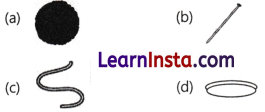
(ii) Which of the following is the example of acute angle?

(iii) Why is the below figure not considered right angle?
![]()
(iv) If two knitting sticks meet at 45°, then write two name of formed angle.
Answer:
(i) Option (b) is the example of a line segment.
(ii) (b) Acute angle is less than right angle.
(iii) Since, right angle has two perpendicular line and angle size of right angle is 90°.
So, given figure can not be consider a right angle, it is an acute angle.
(iv) Since, two knitting sticks meet at 45°. These formed an angle of size 45°, so it is an acute angle or less than a right angle.
Question 2.
Ankit marks five points by folding a rectangular paper sheet as shown below.
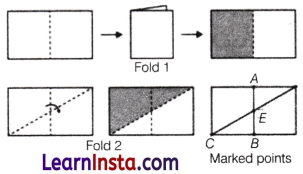
On the basis of the given information, answer the following questions.
(i) CE is an example of
(a) a ray
(b) an angle
(c) a point
(d) a line segment
Answer:
(d) A line segment
(ii) Which of the following is not true for both a ray and a line?
(a) They have end points.
(b) They have start points.
(c) They have no thickness.
(d) They can have infinite length.
Answer:
(a) A ray is a portion of a line, which starts at a point and goes endlessly in one direction, and a line obtained, when a line segment is extended on both sides indefinitely.
Therefore, both does not have end points.
(iii) Fill in the blank with the correct word.
A line segment is a __ of a line.
Answer:
A line segment is part or section of a line.
Skill – Based Questions
Question 1.

Across
(i) The alphabet letter L is the example of
(ii) Measure of an angle is 130°, it is the type of
(iii) \(\overrightarrow{A B}\) and \(\overrightarrow{B A}\) represent two different
(iv) Comparison of small and large angles is depend on the arrjount of
Down
(v) Use to determine location.
(vi) Shortest distance between two points.
(vii) Measure of a right angle in degree.
(viii) Number of end points a ray have.
Answer:
Across
(i) Right angle
(ii) Obtuse angle
(iii) ray
(iv) rotation
Down
(v) Point
(vi) Line segment
(vii) Ninety
(viii) One
![]()
Question 2.
Answer the following questions according to given figure

(i) Bisect ∠1 and ∠2.
(ii) Measure the angle between these bisectors.
(iii) Now, bisect ∠3 and ∠4.
(iv) Measure the angle formed between these bisectors.
(v) What do you observe from parts (ii) and (iii) parts ? Can you conclude something ?
Answer:
(ii) 90°
(iv) 90°
Class 6 Maths Chapter 2 Extra Questions in Hindi रेखाएँ और कोण
Lines and Angles Class 6 Extra Questions in Hindi
बहुविकल्पीय प्रश्न
प्रश्न 1.
चाँदा का प्रयोग …………………….. बनाने व मापने में होता है।
(a) कोण
(b) रेखाखण्ड
(c) त्रिभुज
(d) इनमें से कोई नहीं
उत्तर:
(a) कोण
प्रश्न 2.
निम्न कोणों में से कौन-सा अधिक कोण का माप है?
(a) 60°
(b) 120°
(c) 90°
(d) 30°
उत्तर:
(b) 120°
प्रश्न 3.
निम्न कोणों में से कौन-सा न्यून कोण का माप है?
(a) 30°
(b) 90°
(c) 120°
(d) 240°
उत्तर:
(a) 30°
प्रश्न 4.
एक पूर्ण कोण का माप है।
(a) 180°
(b) 360°
(c) 90°
(d) इनमें से कोई नहीं
उत्तर:
(b) 360°
प्रश्न 5.
दी गयी आकृति में रेखाखंडों की संख्या है

(a) 5
(b) 10
(c) 15
(d) 20
उत्तर:
(b) 10
प्रश्न 6.
9 बजे एक घड़ी की घंटे और मिनट की सूइयों के बीच के दो कोणों का माप है
(a) 60°, 300°
(b) 270°, 90°
(c) 75°, 285°
(d) 30°, 330°
उत्तर:
(b) 270°, 90°
![]()
प्रश्न 7.
दी गयी आकृति में ∠XYZ को निम्न प्रकार नहीं लिखा जा सकता।
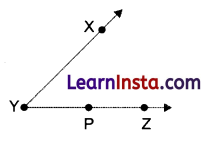
(a) ∠Y
(b) ∠ZYX
(c) ∠ZXY
(d) ∠XYP
उत्तर:
(c) ∠ZXY
प्रश्न 8.
दी गयी आकृति में अधिक कोणों की संख्या है

(a) 2
(b) 3
(c) 4
(d) 5
उत्तर:
(c) 4
प्रश्न 9.
दी गई आकृति में यदि बिंदु A को किरण PX के अनुदिश बिंदु B पर इस प्रकार स्थानांतरित किया जाए कि PB = 2PA तब ∠BPY का माप है

(a) 45° से बड़ा
(b) 45°
(c) 45° से छोटा
(d) 90°
उत्तर:
(b) 45°
प्रश्न 10.
दी गयी आकृति में कोणों की संख्या है

(a) 3
(b) 4
(c) 5
(d) 6
उत्तर:
(d) 6
![]()
प्रश्न 11.
सरल कोण का माप है
(a) 90°
(b) 45°
(c) 180°
(d) 60°
उत्तर:
(c) 180°
प्रश्न 12.
अधिक कोण का माप है
(a) < 90°
(b) > 90°
(c) = 90°
(d) इनमें से कोई नहीं
उत्तर:
(b) > 90°